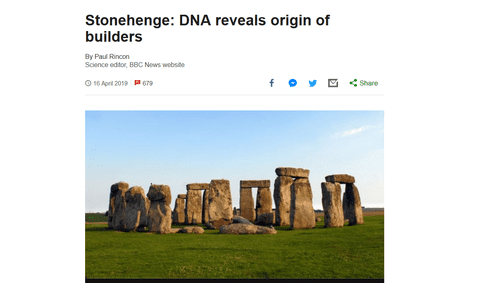See, earlier, by James Fulford: "Actually, There Has Always Been Migration"—But In Those Days They Called It Invading!
From the BBC today:
Stonehenge: DNA reveals origin of builders
By Paul Rincon
Science editor, BBC News website
16 April 2019
The ancestors of the people who built Stonehenge travelled west across the Mediterranean before reaching Britain, a study has shown.
Researchers compared DNA extracted from Neolithic human remains found across Britain with that of people alive at the same time in Europe.
The Neolithic inhabitants appear to have travelled from Anatolia (modern Turkey) to Iberia before winding their way north.
They reached Britain in about 4,000BC.
Details have been published in the journal Nature Ecology & Evolution.
The migration to Britain was just one part of a general, massive expansion of people out of Anatolia in 6,000 BC that introduced farming to Europe.
Before that, Europe was populated by small, travelling groups which hunted animals and gathered wild plants and shellfish.
The dominant anthropological theory before geneticist Cavalli-Sforza in the late 20th Century was that, well, sure, agriculture was invented in the Fertile Crescent of the Middle East, but the farmers probably just taught their friends the European hunter-gatherers how to farm. C-S came up with the then radical idea that maybe the process wasn’t purely Pots Not People, but more like 50% technology diffusion and 50% migration: maybe some of the Fertile Crescent farmers moved west, taking over European terrain from the hunter-gatherers.
One group of early farmers followed the river Danube up into Central Europe, but another group travelled west across the Mediterranean.
DNA reveals that Neolithic Britons were largely descended from groups who took the Mediterranean route, either hugging the coast or hopping from island-to-island on boats. Some British groups had a minor amount of ancestry from groups that followed the Danube route.
But the reality was more like Cavalli-Sforza on steroids.
When the researchers analysed the DNA of early British farmers, they found they most closely resembled Neolithic people from Iberia (modern Spain and Portugal). These Iberian farmers were descended from people who had journeyed across the Mediterranean. …
In addition to farming, the Neolithic migrants to Britain appear to have introduced the tradition of building monuments using large stones known as megaliths. Stonehenge in Wiltshire was part of this tradition.
Although Britain was inhabited by groups of “western hunter-gatherers” when the farmers arrived in about 4,000BC, DNA shows that the two groups did not mix very much at all.
The British hunter-gatherers were almost completely replaced by the Neolithic farmers, apart from one group in western Scotland, where the Neolithic inhabitants had elevated local ancestry. This could have come down to the farmer groups simply having greater numbers. …
The study also analysed DNA from these British hunter-gatherers. One of the skeletons analysed was that of Cheddar Man, whose skeletal remains have been dated to 7,100BC.
He was the subject of a reconstruction unveiled at the Natural History Museum last year. DNA suggests that, like most other European hunter-gatherers of the time, he had dark skin combined with blue eyes.
Genetic analysis shows that the Neolithic farmers, by contrast, were paler-skinned with brown eyes and black or dark-brown hair.
Towards the end of the Neolithic, in about 2,450BC, the descendents of the first farmers were themselves almost entirely replaced when a new population – called the Bell Beaker people
A.k.a., the Yamnaya, or the Battle Axe Culture, or as Nietzsche would have thought of them, the Aryans. But it’s much better to name their after their pottery style, because otherwise boys, who are icky, might get interested in the subject.
– migrated from mainland Europe. So Britain saw two extreme genetic shifts in the space of a few thousand years.
Prof Thomas said that this later event happened after the Neolithic population had been in decline for some time, both in Britain and across Europe. He cautioned against simplistic explanations invoking conflict, and said the shifts ultimately came down to “economic” factors, about which lifestyles were best suited to exploit the landscape.
One population preferred a lifestyle of farming your ancestors’ fields. The other population preferred a lifestyle of crushing your enemies, seeing them driven before you, and hearing the lamentation of their women.
[Comment at Unz.com]













